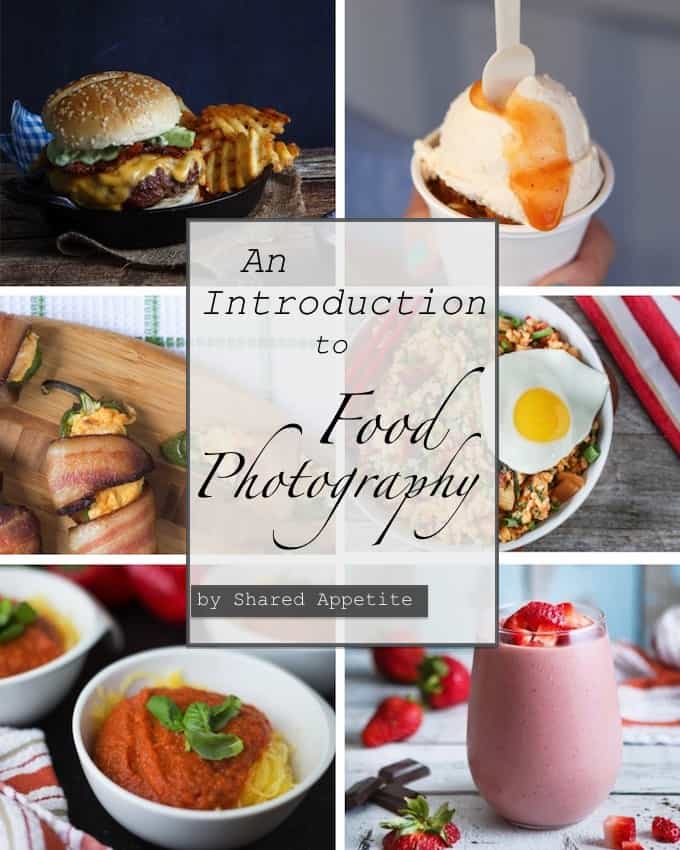
Does your brain hurt? It probably will in a second.
If you're here, most likely you are just starting out in the world of food blogging. Heck maybe you even want to know how to start a food blog. When I was first starting out, reading about the technical aspects of food photography made my head spin. I wanted to get better, but all the gibberish just didn't make sense to me.
Aperture, f stops, white balance, ISO... huh? What?! Ugh...
The best piece of advice I can give you? Dive in and do it. Don't just read. Practice. Over and over and over. Pick up your camera, put it on manual, and shoot everything you can. Experiment. Take 100 photos a day. The more you just do it, the faster you'll learn.
But here we go. I'm going to try to give you the very basics, in a way that doesn't make your brain (or my brain) hurt. And after that, pick up your camera and start practicing 🙂
So here we go. An introduction to food photography.
Grab some coffee. Or if you're like me, some chocolate. Dark chocolate to be exact.
Shoot Manual.
Your camera has all sorts of settings. Most likely you started on the auto setting. The good thing about auto? The camera pretty much makes all the decisions for you in order to produce an "acceptable" photograph. The bad thing about that: the camera pretty much makes all the decisions for you.
And as scary as this sounds, you want to be in full control of your camera. That's right. Own it. Embrace it. The camera isn't the talent. YOU are the talent.
But I don't know what to do!!
Patience, my friend. Patience.
You just have to decide to make the switch. Go manual. Do it. You'll struggle for a bit, but then you'll get it . And it will be glorious. Glorious victory indeed.
On Camera Flash.
You know that thing that pops up from your camera? It's worthless. Actually, it's worse than worthless. Those built-in on camera flashes on many cameras have the uncanny ability to ruin all hopes of getting a great image of food.
Don't trust me? Jeez. I thought we were cool, you and me. hmffhhhh...
Well, just take a look at some of my absolutely stunning, breath-taking photographs from a few years back utilizing the on camera flash...
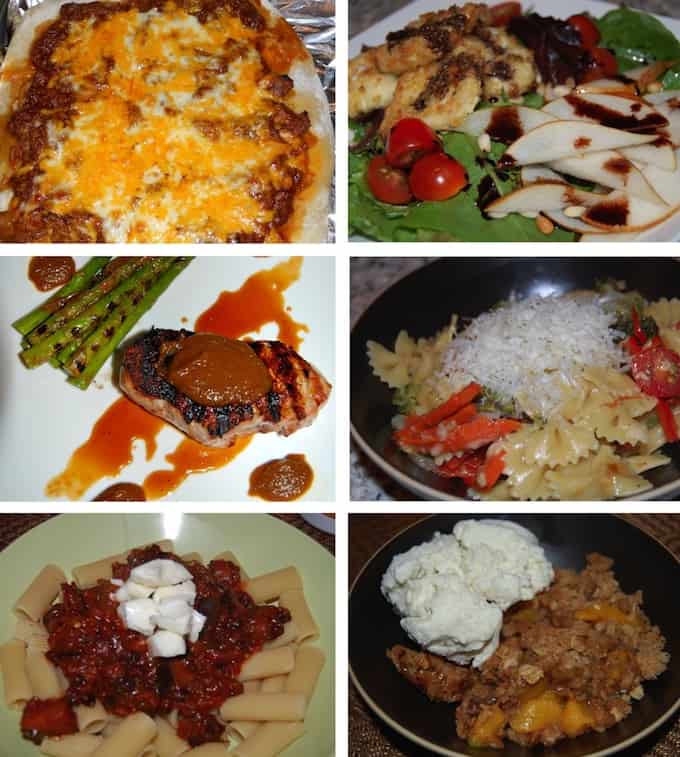
Ah, the beautifully diffused light. Don't you just love how it just kisses the food in such a way to make it look absolutely irresistible?
Of course not! That food looks ugly. Unappetizing. Gross.
Darn you on camera flash!!! Darn you.
So do yourself a favor. Step one to getting better food photographs? Don't even think of using that flash.
How To Say Goodbye to Auto. Forever.
Here's where you're going to need that coffee. Or chocolate. And chocolate?
Shooting manual basically means you are controlling, manipulating, and balancing 3 basic photographic elements. Aperture, ISO, and Shutter Speed. Here's a good visual diagram.
And those three things work in harmony with each other to produce your image. It's your job as the photographer to balance the aperture, ISO, and shutter speed depending upon the situation and/or scenario of what you are photographing.
Aperture.
Aperture allows more light or less light to reach the camera sensor. With manipulating the aperture, you can create a shallow or deep depth of field (lots of blur or not a lot of blur).
It's measured in f/stops (i.e. f/1.2, f/2.8, f/4.0, f/10, etc.). Whoa. That was a lot of words being thrown around. Here's an equation for you to memorize.
large aperture (low f/stop)= shallow depth of field = more blur in the photos
small aperture (high f/stop) = deeper depth of field = less blur in the photos
Warning. With blur comes great responsibility.
Careful of f/2.8 and other very low f/stops in food photography. Because there will only be a small amount of your image in focus, it may become difficult to get enough of the food in focus to create appetizing images. I rarely go lower than f/3.5.
Notice in the photo below that as the f/stop gets higher, more of the food is in focus (look at the waffle fries).
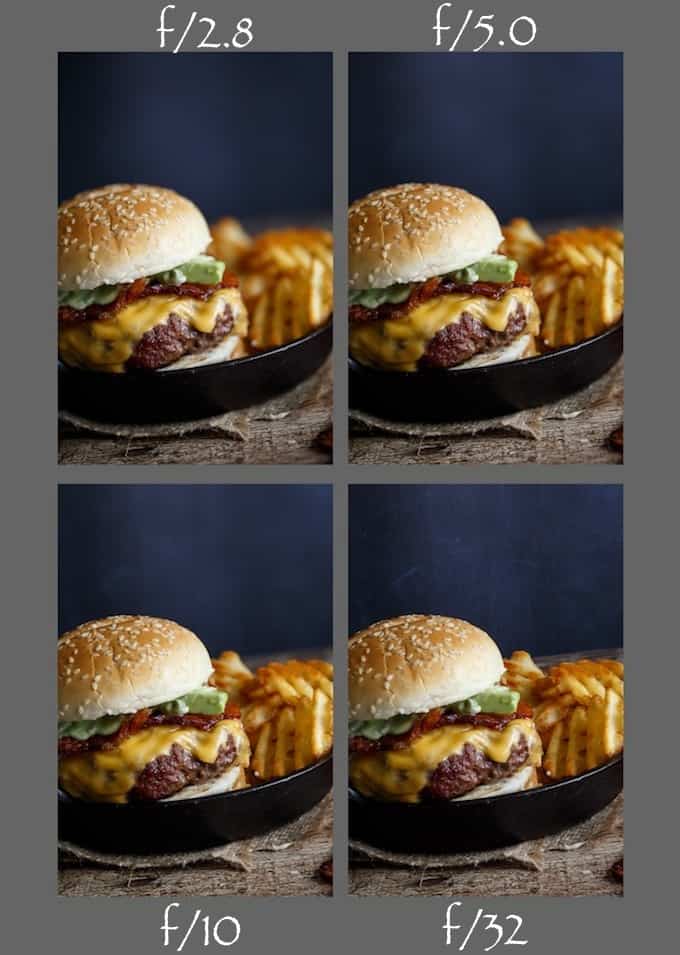
pictured: Stuffed Jalapeno Popper Bacon Cheeseburgers
A word about aperture and light. If you don't change anything on your camera except for your aperture, you'll notice that at lower f/stops, you don't need as much light as higher f/stops.
Low f/stops = less light needed
High f/stops = more light needed
In situations where light is scarce (like at many restaurants), you may need to keep your aperture large (low f/stop) to produce a properly exposed photograph.
ISO.

Take a close look at the above photo. You'll notice that in the ISO 400 image, it's clear, smooth, and clean. The other two images, however, are grainier.
ISO basically controls how sensitive your camera is to light. ISO typically goes as low as 100 and depending upon your camera, can go up to around 10-25K.
The higher the ISO, the better the light sensitivity. Basically, that means the camera is capturing more light. This is great when you are in a dark environment, like those two restaurants I was in when capturing the two photos in the above left.
But here's the catch. As the ISO increases, so does the grain or noise in the photo. In addition, higher ISO's will also mess with the color in the image a bit.
Lower ISO = more light required = smoother, cleaner images
Higher ISO = less light required = adds grain to your images
It's also importnat to note that ISO affects cameras differently. When you purchase a more high-end camera, it can handle higher ISO's better (show less grain and capture better color).
Bottom line... always try to keep your ISO on the low side. I typically try to keep it around 400.
Shutter Speed.
The thing you hear clicking when you take a photo (cchhkk, cchhkk)... that's the shutter. And its speed will determine how long your camera sensor will be exposed to light.
If you are taking a photo of something that is moving, a faster shutter speed will be needed to freeze the image.
Shutter speed is measured in seconds. 1/60th second. 1/125th second. So on.
Faster shutter speed = less light coming in = freezes images quickly
Slower shutter speed = more light coming in = can be blurry
If you are taking handheld photos with your camera (without a tripod), plan on shooting at a minimum shutter speed of 1/100. Anything slower than that and you run the risk of a blurry image due to camera shake.... unless you have crazy steady ninja surgeon hands. In which case, I hate you. #kiddingnotkidding
I use a tripod and remote for almost all my photos at this point because it helps me to create more consistently clear and reliable images, and also aids in the composition and food styling. It also allows me to shoot at slow shutter speeds (and keep my ISO low!) while maintaining clear images.
JPEG vs. RAW.
When photographing, you have two choices.
Innnnnn this corner, weighing in with consdensed, smaller files, is JPEG.
Although it is a tinier file, it doesn't allow for a lot of room for post-processing (i.e. editing your images in the computer).
And in this corner, with much larger files and potential for editing, is RAW.
This is how I photograph every image. Although it does take up a whole lot more room, raw files capture all the information the camera receives when you click that shutter. That way, you can enhance and edit your images in post-processing (I highly recommend and personally use Lightroom).
Taking Your Photos To The Next Level.
What is a great food photo? In my mind, it's something that catches and holds your attention, and generates emotion in you... preferably intense, uncontrollable hunger. I want people to say... Ermagherd! I want to eat that.
So here are some things to get that type of Ermaghred! reaction.
Light.
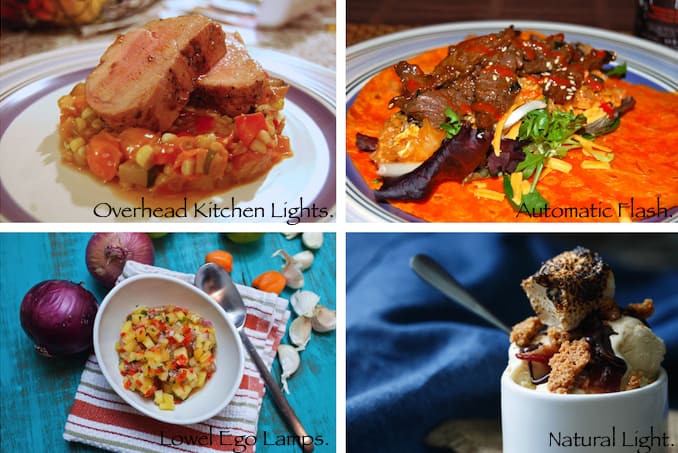
As you can tell in the above photo, just photographing with the overhead kitchen lights on is pretty nasty. We already know that automatic flash stinks. Natural light is totally beautiful. And in a pinch... if it's dark out, those Lowel EGO Lamps do an okay job (and are what many food bloggers use when they need to photograph something at night).
When it comes to light, you've got options. Don't take it lightly.
Get it? Get it?
I said lightly. And we are talking about light. I crack myself up.
Be serious, darnit. How you use and manipulate light is the most important aspect of photography. No pressure or anything.
My favorite type of light is the au naturel kind (i.e. the sun). Specifically, beautiful diffused sunlight (not harsh, direct sunlight). Harsh natural light will wash out your subject and cast heavy shadows, making the food look bleh and unappetizing.
So how do you make sunlight look good?
If it's cloudy out, nature pretty much already did the job for you. Clouds act as a natural diffuser. If it's sunny, you could use a diffuser (that's the one I personally use and love) or a pure white sheet/ fabric to soften the light.
Light is pretty darn important. It's the thing that professional food photographers are masters at. Finding the light. Stalking the light.
You have homework. Ready?
Try shooting at different times of the day and in different locations of your home to figure out what window gives you the best light... and at what time.
Directional Light.
Once you find that killer light, it's time to think about how you want it to hit your food. We call it... directional light. I know, so fancy.

And you have options. Above is an example of what it looks like when you light something from the left or the right. Do you see where the shadows falls?
You can also light images from the back or the front.
If you want a good rule of thumb about directional light, you pretty much never want to light your food from the front. Food looks best lit from either the back, one side, or a combination of the two (i.e. back + right or back + left).
Reflectors.
And obviously when food is being lit from one side, it will cast a shadow on the other side. Duh.
Now, shadows are not a bad thing. It's personal preference. I see and love beautiful, bright images without shadows. I also love photos that use shadows to create mood and shape an image.
I've been experimenting more and more with using dramatic and creative shadows in my images, but many times you will want to lighten up the dark side of the image at least a little bit. That's where reflectors come in. You can use basically anything white.
White foam core board and white oak tag both work well. Basically, anything white that can bounce light back onto the food to fill in the shadows will work.
In the image below, light entered from a window on the left side. I used a white foam core board on the right side of the sundae in order to minimize the shadows in the right image. Which look do you prefer?
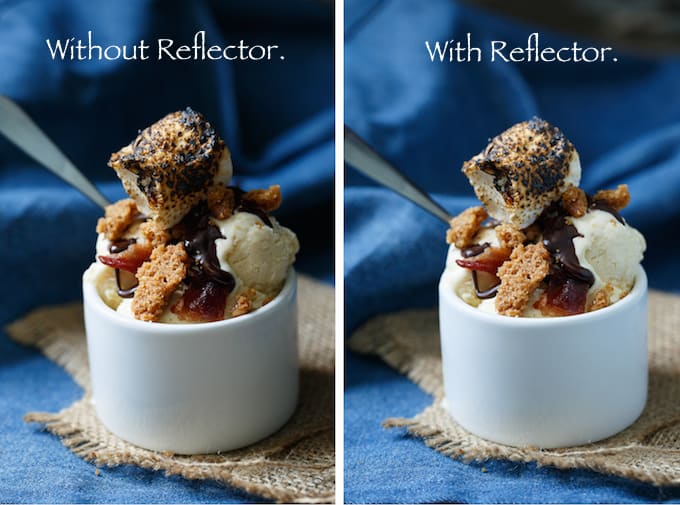
pictured: The Ultimate S'mores Sundae
When I'm photographing food for Shared Appetite, I always try it both ways. With reflector and without reflector. That way I can make the final creative decision later on while editing images on my computer.
Oh, and do me a favor. Make sure when photographing to turn off those overhead lights. I can't tell you how many times I was utilizing natural light for my images but totally forgot to turn off the kitchen lights. When you mix light sources, it becomes virtually impossible to white balance your photos.
White balance?!
I told you your brain would start hurting...
White Balance.
Every light has a temperature, which results in a slightly different color. Flourescent, Tungsten, Incandescent, and even natural sunlight each have a different temperature on the Kelvin Scale.
And even with natural light, the temperature (and color!) will change from blue to yellow/orange as the day progresses and depending upon how sunny versus cloudy it is.
White Balance is simply making whatever light your using look as close to pure white as possible. You can do this in your camera or in your photo editing software on your computer (such as lightroom or photoshop).
When photographing, I start by simply choosing the white balance temperature preset in the camera menu that's closest to pure white. Each camera menu looks different, but here's an example:
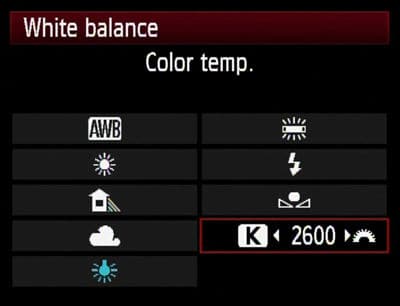
And here's a look how each of those white balance presets will look...
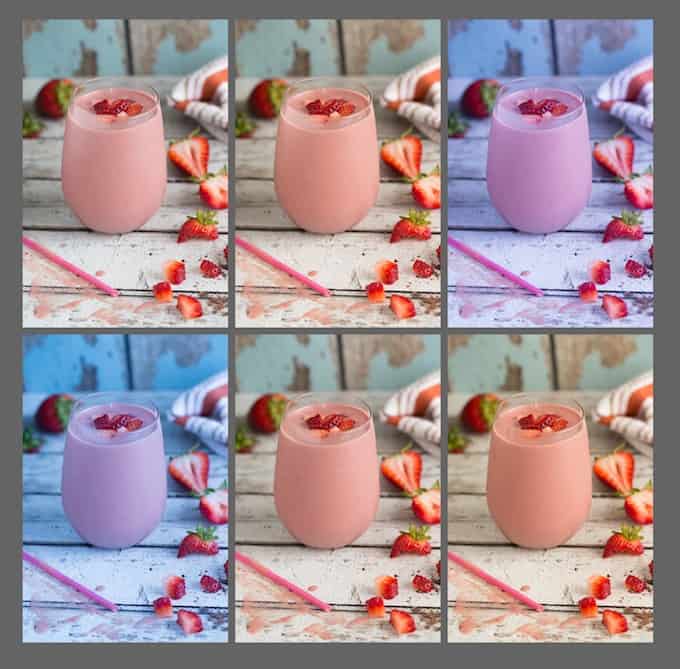
pictured: Dark Chocolate Strawberry Smoothies
Obviously I would choose the upper left hand white balance preset (which I believe was "daylight" (the sun icon).
Even though the color (i.e. white balance) in that image isn't perfect, it's close enough so I can tweak it in Lightroom by using the two tools circled below.
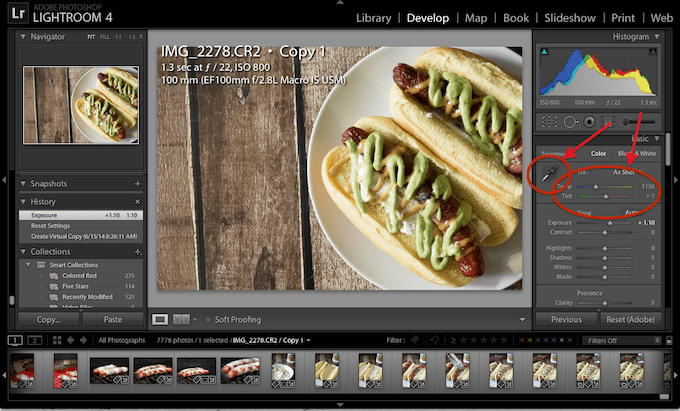
Click the eye dropper tool and then click on a white or neutral gray area of the photo, and it will adjust the white balance accordingly. That normally gets it closer to where I want it, and then I use the two sliders (blue to yellow temperature, and green to pink tint) to fine tune the color of the image. When I'm done, it looks more like this...
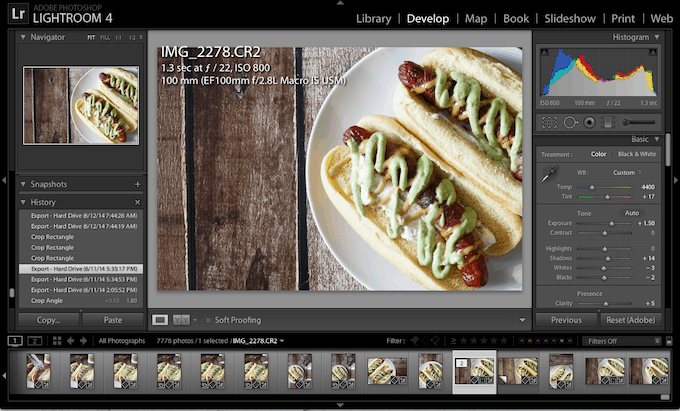
pictured: Bacon Wrapped Jalapeno Popper Hot Dogs
Here's another look at what white balance can do to a photograph. No other editing was made other then correcting the white balance...
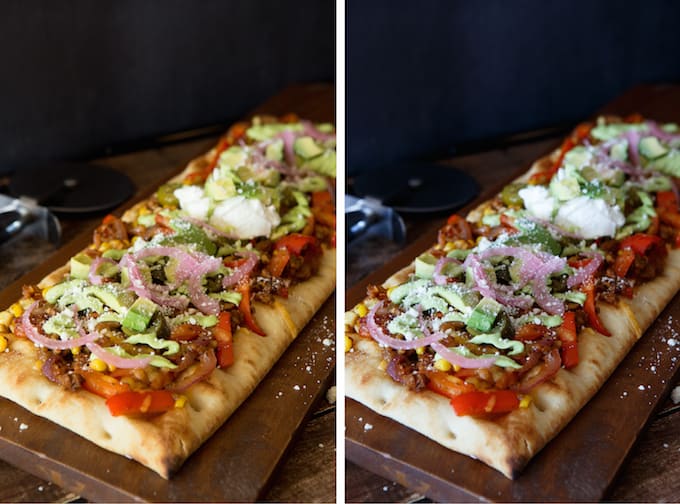
pictured: Vegetarian Beef Fajita Pizza
The image on the left was "as shot" out of camera. On the right, I fixed the white balance in my Lightroom editing software. What a difference!
Composition.
This is where your artistic creativity can shine through. Here are some things to consider with regards to composition...
Point of View.
Whenever Tyler and I are doing an engagement session or photographing a wedding, our couples typically let us know that they have a good side.
Get me from my good side!
Food kinda has good sides too. You can shoot your food from above, head on, or from a compromise of the two (¾):
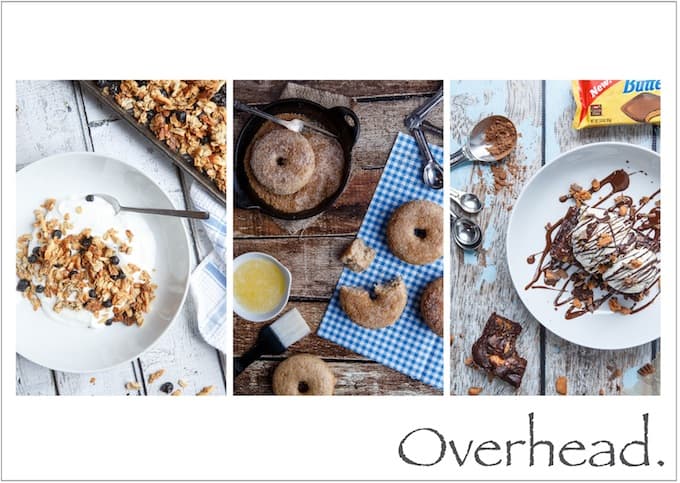 pictured:
Gluten-Free Blueberry Almond Granola with Chia Seeds
Baked Brown Butter Churro Donuts
Chocolate PB Fudgy Avocado Brownie Sundae
pictured:
Gluten-Free Blueberry Almond Granola with Chia Seeds
Baked Brown Butter Churro Donuts
Chocolate PB Fudgy Avocado Brownie Sundae
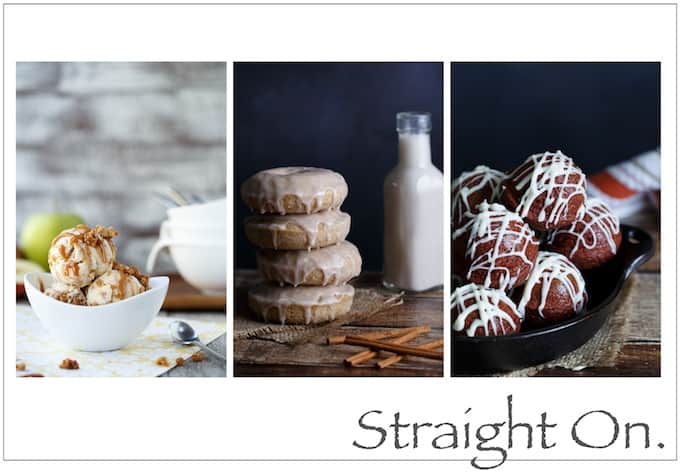 pictured:
Apple Crisp Ice Cream
Baked Horchata Glazed Donuts
Baked Red Velvet Donut Holes with Cream Cheese Glaze
pictured:
Apple Crisp Ice Cream
Baked Horchata Glazed Donuts
Baked Red Velvet Donut Holes with Cream Cheese Glaze
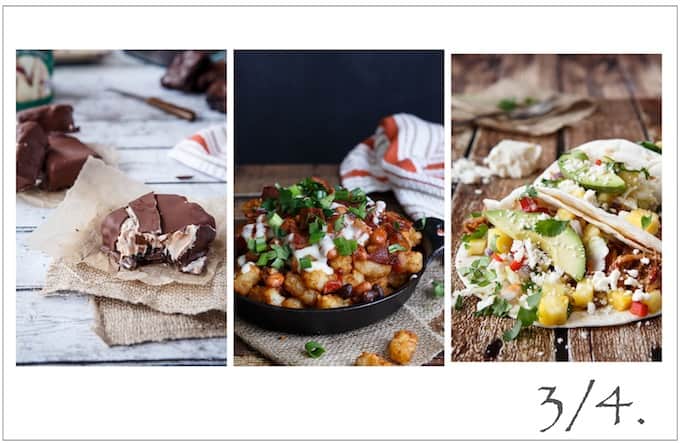
When photographing a dish, I always try it at a few different angles. I'll start with the vision I have in my head, and then will try playing around with it a bit.
Messy.
You want to be thoughtful and deliberate in your composition, but at the same time want it to look natural and unforced. Super neat and clean images where everything looks absolutely perfect sometimes aren't the best images. Sometimes, it's good to be a little messy 🙂
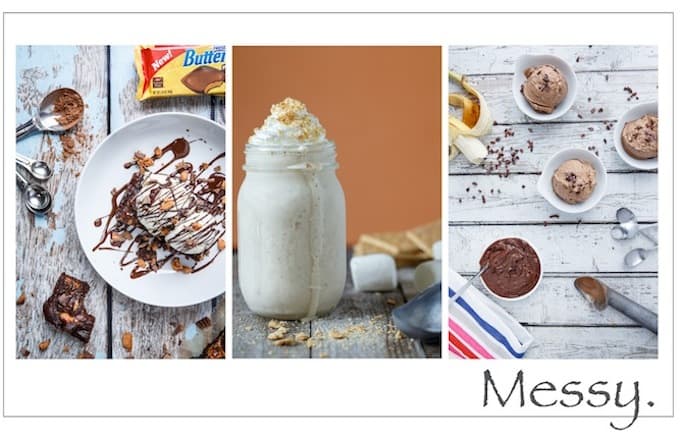
An artistic dribble. An eaten brownie. A spill of cocoa powder. Broken graham crackers. All of these things can add to an image.
Props.
Every movie needs supporting actors, even if it does star Vince Vaughn.
Don't just think about the main star.
Think about what props can act as supporting actors to create an oscar-worthy movie. Maybe offer a pop of color. Or some texture. Or add information to what ingredients are in the dish.
Backdrops. Plates. Linens. Utensils. Kitchen towels. Trays. Even food!
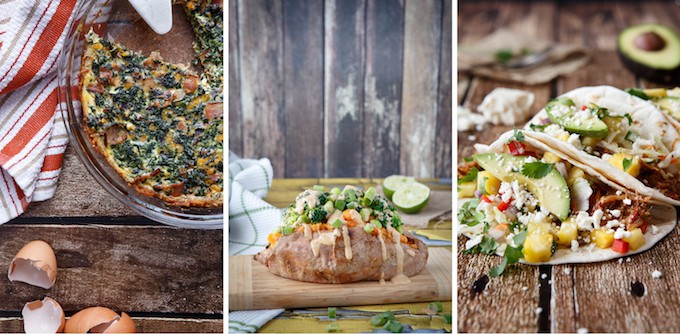
Just be careful not to overdo it. Sometimes less is more. You want props that will enhance the image, not take over it. Overly cluttered images can overwhelm the eye.
Rule of 3rds.
Although I don't actively think about it, be mindful of the rule of thirds. When you place points of interest in photos where the grid lines intersect, it apparently makes for a more balanced and interesting photo.
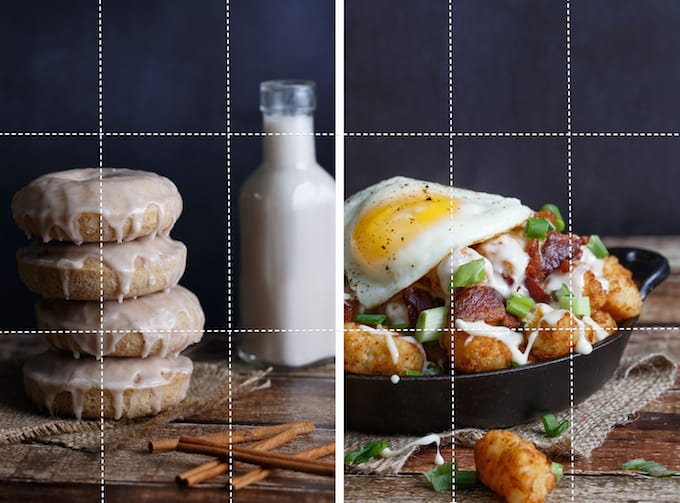
EQUIPMENT.
Listen, without a doubt, the most important equipment you'll ever own is YOU. Cameras don't take great photographs. You do.
But, having some great gear certainly does help. Just click on that big fat image below and it'll take you to all the gear I currently use and love.
Check out My Favorite Food Photography Gear.
LEARN MORE.
I know. That was a lot of info. I'm sorry. I remember how overwhelming it was when I was just starting out. The good news is that it gets easier. And if you want a super-duper, ridiculously awesome resource for pretty much everything you need to know about food photography (including great video tutorials), you'll want to check out Lindsay's Tasty Food Photography eBook.
I bought it awhile back when I first started out and it literally walks you through everything you need to know to start capturing amazing images. The best part is that Lindsay's eBook is full of images, which demonstrates and gives you visual examples of everything she's talking about.
Just click on that beautiful book below and it'll take you to her page for more info...

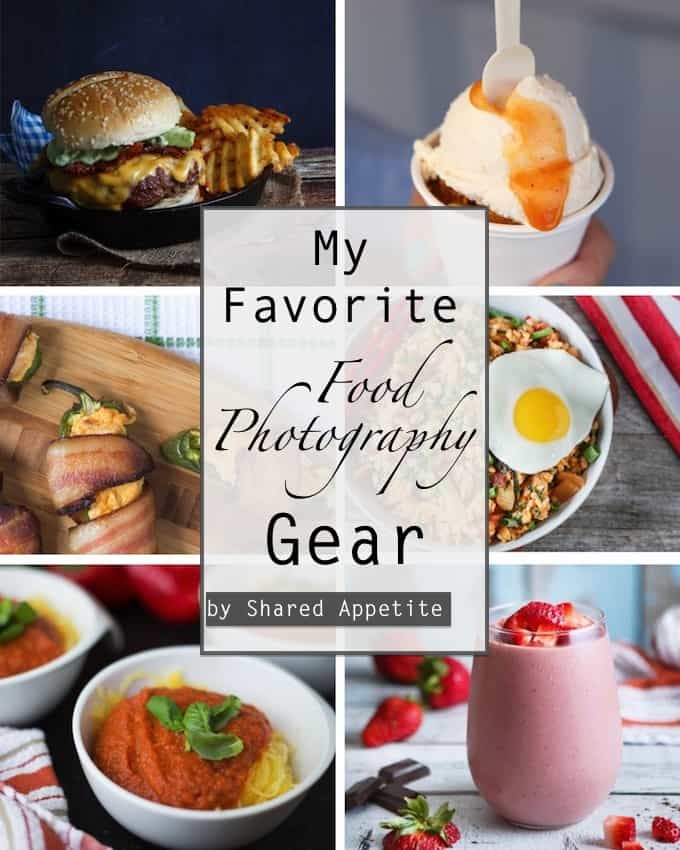
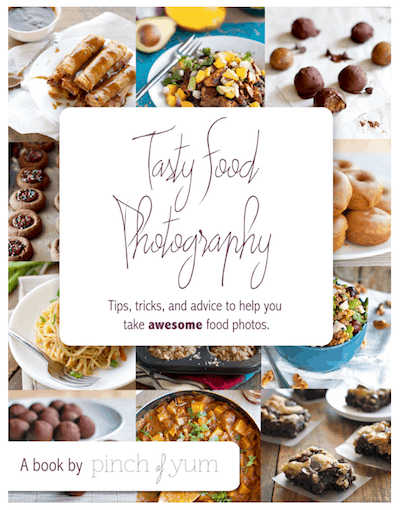
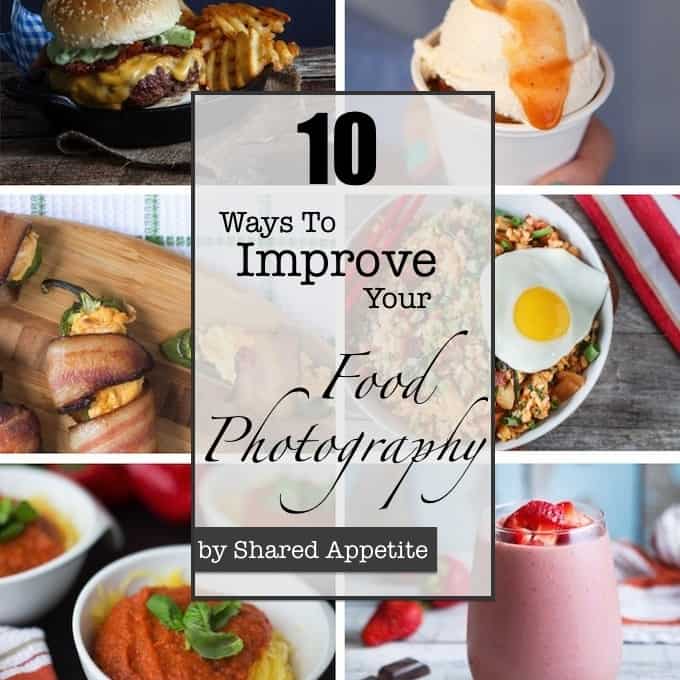
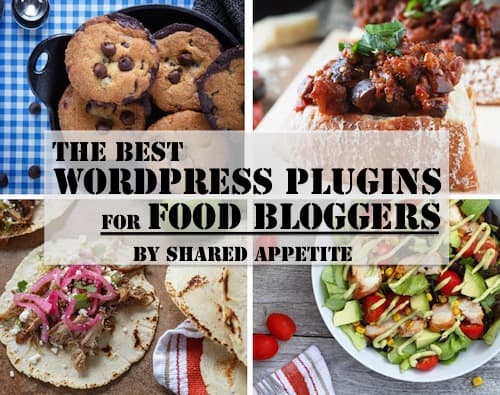
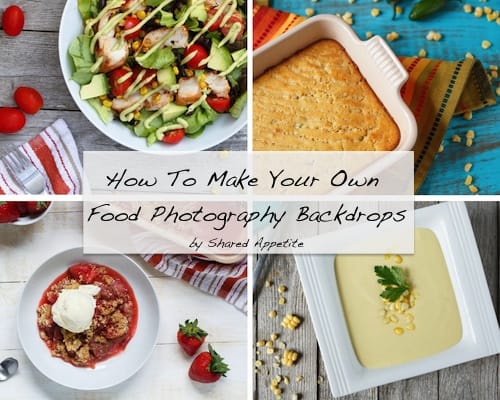
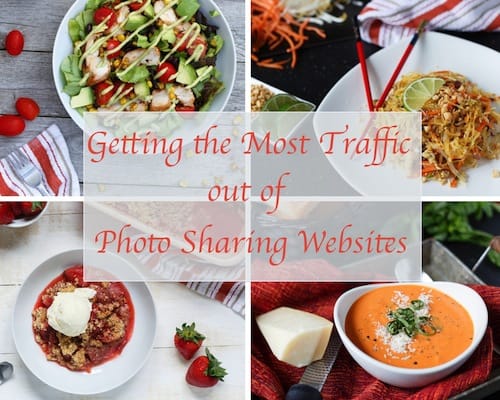
Alice says
This is awesome and so detailed!! love what you said about "thing that pops up from your camera." love it!
Chris says
Hahahaha thanks Alice!
Beth says
Wow, this is awesome Chris! I always love reading posts like this. I feel like I can never read enough of this stuff because I always learn something new! This is an incredible post, and so so detailed!! Wonderful job! 🙂
Chris says
I'm the same way Beth! I'm always drawn to these types of posts too b/c I love learning and improving!
Ceara says
WOAH. Thanks for such an informative post - thoroughly enjoyed it (and learned a lot too!). The photography aspect of the blog is definitively the most difficult for me - I live in a small apartment with little natural light (#studentlife) so do the best I can! I am happy to say I no longer take pictures for my blog at the dinner table with flash and overhead kitchen lights in place (learned that much this far :D). Looking forward to trying some of these techniques with my next recipe!
Pinned to my "DIY Blogging" board!
Chris says
So glad you found it useful Ceara! Yea that must be so hard to photograph without any natural light!! Have you looked into the Lowel Ego Lamps?
Bianca says
Great tips, Chris! I also have that ebook from Pinch of Yum and learned a lot from it.
Chris says
It's great, isn't it?!
Tina says
Wonderful advice, Chris!
Chris says
Thanks Tina!
marcie says
Chris, this is AWESOME! I have so many food photography books, and I'm so bad -- I use Auto because I'm lazy and I've forgotten everything that I've read in my books. Your photos are always incredible, and I need to get off my you-know-what and start taking control. haha Pinning!
Chris says
Thanks so much Marcie! Yes, totally start taking control... it's SO worth it!
Ashley says
haha the on camera flash section made me chuckle. I used to use it when I first started since I didn't know any better and the photos make me cringe when I look at them now!!
And totally agree on manual - it's a beast to learn but once you do - makes it all worth it!
Chris says
Hahaha ohhhh weren't we silly back then. It's so funny how far we've all come!
Sarah says
This is such a great resource, Chris! You obviously put SO MUCH time into this and it shows. I'm always impressed by your photography:)
Chris says
Thanks so much Sarah... much appreciated!!!
Alyssa says
I love this post, Chris! SO super useful and I love all the info you've managed to squeeze in here. I'm still learning the ropes of my new DSLR so this comes at the right time for me! Repetition, repetition, repetition!
Chris says
So glad you found it useful!
David says
Amazing work, my friend! This will become a go-to guide for many years to come. #WolfpackPhotographyStudios
Chris says
Hahaha I like that... let's open up a studio somewhere immediately.
Shashi says
Chris - thank you for this! I have learned so much - and I am not saying that lightly - AND - my brain doesn't hurt! I printed out that "Aesthetic exposure triangle" and it has notes all over it from your tutorial - had to pick my jaw off my desk looking at those photos of using a reflector/not and white balance comparison! Thank You Thank You!
Chris says
Hahaha wow it didn't hurt your brain?! You must have a very strong and fit brain 🙂
Tina says
Awesome tips! I'm always looking how to step up may game. 🙂 Pinned!
Chris says
Thanks so much Tina! Glad you found it useful 🙂
Kelly says
What an excellent post Chris! Loved everything you wrote here - haha especially loved what you called the flash:) I was guilty of using that when I first started the blog too tstk tstk. I am always trying to improve my photos so I I loved all these tips 🙂 Awesome job!
Chris says
Thanks so much Kelly!
Dannii says
Thank you for sharing these tips! I am bookmarking it as I really need to work on my food photography.
Chris says
Thanks so much Dannii! Glad you found it useful!
Layla says
This such a great post!! Love all of your tips! Thanks for sharing
Chris says
Thanks so much Layla!
Pamela says
"When it comes to light, you’ve got options. Don’t take it lightly. ". Muhahahaha, thanks for the smile.
Chris says
Glad my lame puns made someone else smile besides me hahaha
Nicole says
Love this Chris. I've been doing a lot of what you suggest here, so that's good. I'm lucky enough to have a seasoned blogger as a close friend and she pretty much taught me everything that you talk about here. It's so much information to take in though so I'm glad I have your post to refer to now. Thank you! BTW... Love your awesome recipes and pictures too.
Chris says
Thanks so much Nicole! Having a friend like that is a big win!
Helen says
Great post, Chris. I've managed to figure out much of this for myself over the last few years (with a lot of help from posts like this!) but there were still a few new tips in here for me to think about. I have to admit I constantly struggle with light. I think when I get back to the UK very soon those lowel Ego lights will be pretty essential!!
Chris says
Yea, totally look into those lights... they are pretty darn good when it's dark out and you have no other option!
Amy | Club Narwhal says
Chris, this is a phenomenal resource--I especially love the composition section! And I totally agree--just diving in and using my new fancy camera was the quickest way to feel more comfortable and confident working with it.
Chris says
Thanks so much Amy! Glad you liked it!
GiGi Eats says
Food photography, so not my foray! AT ALL. However, I have just been realizing that food photos are REALLY IMPORTANT if you want to have a successful food blog, so I have been trying to get FANCY... With my iPhone and a few tiny editing tweaks, and you know what? Not too shabby! Still learning, but it's been okay!
Chris says
You can take great pics with a phone!
Paula B says
Wow! Thanks Chris, this was so helpful! 🙂
Chris says
Glad you found it helpful Paula!
Raquel says
Hi Chris! Stopping by from Weave - congrats on being the featured blogger. Also thanks for this great tutorial. Photography is definitely an area I can improve on. Great tips!
Chris says
Thanks so much for stopping by Raquel! Glad you liked the tips!